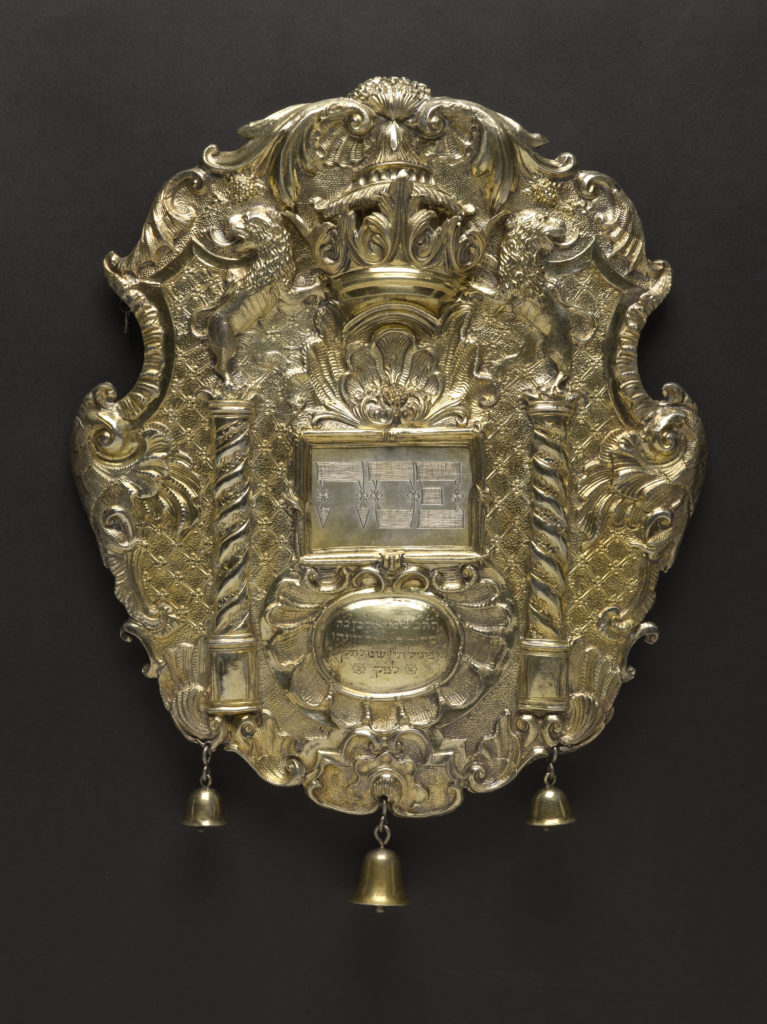Torah Shield (work of art)
Artwork Info
Key Ideas
- This Torah shield was crafted in silver and then gilded, or covered with thin sheets of gold leaf or gold paint.
- The shield includes symbols that are often depicted on Judaic objects: a crown, two columns (representing the gates of the ancient Temple in Jerusalem), and bells (worn on the ancient Temple high priest’s ritual clothing).
- Augsburg is in southern Germany, in the German state of Bavaria, near the border with Austria. Bavaria was an independent territory before joining the unified German Empire in 1870.
- This shield is symmetrical, or equally balanced on both sides of its center.
Learn More
Among the most important types of Judaic objects is the Torah shield (Tas in Hebrew). In the Ashkenazi (Central and Eastern European) tradition, the Torah shield is part of a decorative ensemble that covers the Torah scroll when it is not in use. Torah shields often serve a practical as well as a decorative purpose. They are based on similar breastplates worn by the ancient high priests in the Temple in Jerusalem.
The Torah shield is hung by a chain from the protruding staves (handles) of the draped Torah scroll. Usually made of silver or silver gilt, the shield often features symbolic references to the majesty and authority of the word of God. In this example the “Crown of the Law (Torah)” is on top of the central plaque that represents the Torah reading. Originally the shield had other plaques (pieces that could be inserted into the rectangular and oval frames) that were changed to mark a particular holiday. The only surviving plaque notes Pesach (Passover) on one side and Sabbath on the other. On either side of the plaque, there are twin columns representing the pillars (Jachin and Boaz) that stood on either side of the entrance to Solomon’s Temple (1 Kings 7:13–22, 41–42). The “lions of Judah” stand on top of each column, symbolizing strength and the Jewish people.
The city and the maker’s marks are stamped into the surface near the bottom of the shield. A pyr, or pine cone, identifies the city of Augsburg, one of the centers of European metal arts in the 1600s and 1700s. The letter H signifies the year (1747).
The initials “HM” identify the maker as Hieronymus Mittnacht, a prominent Augsburg silversmith who specialized in Judaica. With its dense and swirling ornament, this shield is a masterpiece of ornamental design known as rococo during the 1700s. The shield was originally commissioned for a Bavarian village synagogue. The cartouche (a carved drawing representing a scroll with rolled-up ends) at the bottom includes the original Hebrew dedication by “the esteemed Kohen (priest) Samuel Joseph Ezekiel, of blessed memory, and his wife Feygl, may she remain among the living, in the year [5]509 [1749].” The central plaque indicates the Torah reading for Passover.
Additional Resources
Resources for Teachers:
- Learn how to make an Egyptian cartouche.
- Read an article about the Torah breastplate.
- Read an article about public readings from the Torah in Jewish rituals and on holidays.
Resources for Students:
- Watch a video to learn how to dress a Torah scroll.
- Watch a video to see how a Torah is lifted and covered (or dressed) after a service ceremony.
- Watch a video to learn more about symmetry.

